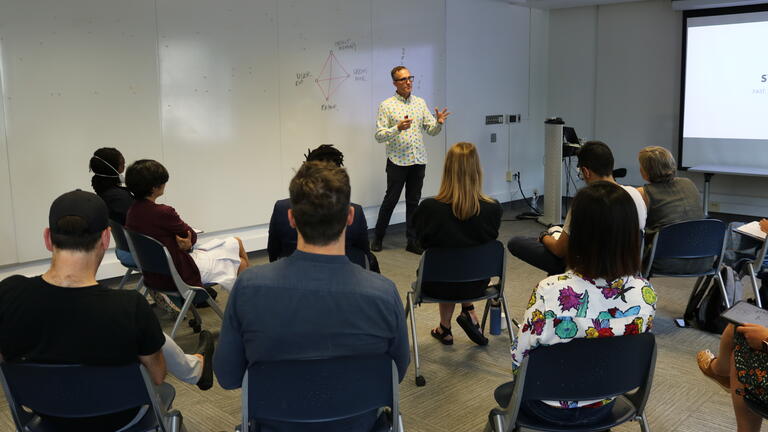
Doctoral Program Admissions
How To Apply:
The GradCAS application for admissions will be available December 2025 until February 28. Click Here.
Application Checklist:
All prospective PhD researchers must submit an online application to GradCAS that includes:
- A Personal Statement
- Samples of Work
- CV
- Three letters of recommendation
- Official transcripts
- Application Fee
- One English proficiency exam if required:
- TOEFL composite score for admission is 100, with minimum subscores of 25. The School of Design accepts iBT, iBT Home, Essentials.
- IELTS- The recommended composite score for admission is 7.5.
- Duolingo- Our recommended DET score for admission is 130 total. Individual subscore minimums for admission: Literacy: 115, Conversation: 120, Comprehension: 125, Production: 110.
- Application fee
Detailed information about each component of your application:
-
Describe your reasons for wishing to undertake a PhD in Transition Design, and how your unique personal and professional experiences have led you to this moment. Explain how your work overlaps with the Transition Design approach, and why this intersection could provide fertile ground for doctoral research. Tell us about what drives your work and the key research questions you are currently grappling with. We are not looking for a “research proposal.” Our program is fairly unique in that we develop this after the first year of study. Your statement should be around 12,500 characters in length.
-
We are interested in seeing examples of your recent work. This could be anything from a design portfolio or curriculum you have developed, to a collection of short articles you have written or descriptions of community-based projects you have been involved with. Whatever you decide to share with us, it should be supported by annotations clearly describing each piece. You can upload samples of your work as a single PDF, or include a link to a personal website. We typically like to see around five or six pieces of work.
-
This should include your academic qualifications, work experience, and list of notable research and/or professional outputs.
-
Provide names and contact information (including email addresses) for three people you have chosen to write letters of recommendation on your behalf. These are people who can write a compelling, thoughtful letter about your approach to work, and readiness for doctoral study.
-
In the GradCAS Academic History section, please request an official electronic transcript from U.S. schools you attended. Select the appropriate electronic transcript vendor and follow the instructions for Sending Transcripts Electronically to GradCAS, as found in the GradCAS Help Center. GradCAS accepts electronic transcripts from Credentials Solutions, Parchment, and National Student Clearinghouse.
International transcript(s) that cannot be sent electronically using Credential Solutions, Parchment, and National Student Clearinghouse must include a foreign evaluation of the academic record. WES and ECE can be ordered directly through the application. Original documents should be sent directly to GradCAS at the listed address below. The School of Design does not accept transcripts or evaluations through email or postal service.
GradCAS Transcript Processing Center
PO Box 9217
Watertown, MA 02471 -
If English is not your native language and you are not a U.S. citizen of an exempt country you must submit one valid English proficiency score from one of the following administrators: TOEFL ( Test of English as a Foreign Language), IELTS ( International English Language Testing System), or the Duolingo with individual subscores. All applicants must submit their highest test score by the application deadline. TOEFL/IELTS scores must be less than two years old. If you are submitting the Duolingo test, which can be taken online, please verify that you are administered a 2020 or later version with individual subscores.
- TOEFL-Please upload an unofficial score report via the Documents tab in the Program Materials Section and send official scores to GradCAS using code: B886. Our minimum TOEFL composite score is 100, with minimum subscores of 25. In addition to single test date TOEFL iBT scores, the School of Design also accepts MyBest Scores for TOEFL iBT.
- IELTS- The School of Design is registered to receive IELTS scores electronically through GradCAS. Applicants must contact the IELTS test center where the IELTS test was taken to request the official Test Report Form be sent electronically to the GradCAS E-Delivery account, thereby granting permission to share test results with CAS services. We do not accept unofficial copies of IELTS Test Report Forms from applicants. An institution code is NOT required. The minimum composite score is 7.5.
- DuoLingo- The official scores will be sent electronically to "Carnegie Mellon University- School of Design" by DuoLingo. Our recommended DuoLingo score is 130 total. Individual subscore minimums: Literacy: 115, Conversation: 120, Comprehension: 125, Production: 110.
-
Each applicant must submit a $75 application fee.
When You May Apply:
The GradCAS application for admission to 2026-2027 will be available December 2025. Click Here
Decisions:
Offers are made after all applications have been reviewed, usually around the end of March.
Further Information
Please feel free to write to doctoral-info@design.cmu.edu with any questions. You can also check out our FAQs page. As this is a relatively new program, insufficient data exists to provide helpful transparency statistics. This will be shared as it becomes available.